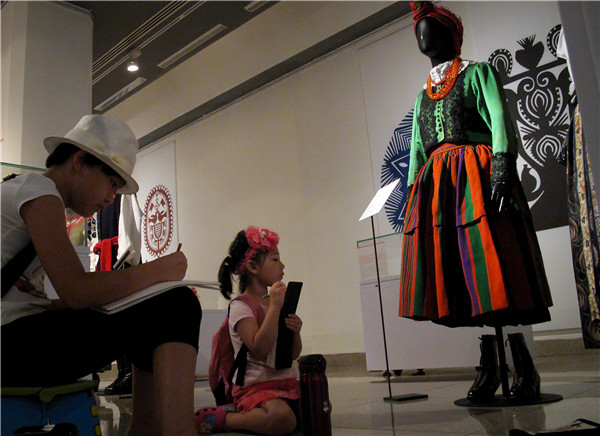 |
|
An exhibition of folk art in Beijing provides learning material for young artists. [Photo by Jiang Dong/China Daily] |
On many visits to museums over the past year I have come across groups of students in exhibition halls, often with a staff member of the museum introducing them to the items on display.
Enthralled by their interest, I have sometimes tagged along, listening to their conversations, as if to make up for what I missed out on in my student days.
Students today are benefiting from big changes to the country's education system, which has included museum lessons as part of school curricula. Last September, schools in Beijing were instructed to take students to museums at least twice a month, and museums have been asked to set up or upgrade their educational wings to meet students' special needs.
Students taking this year's high school entrance examination found that frequent museum visits could have got them higher scores, because museum-related questions were part of all the five subjects: Chinese, English, physics, chemistry and, yes, math.
These measures are aimed at changing the way knowledge is acquired in China. The country's education system is famous-some might say notorious-for its emphasis on rote learning. Students spend a lot time memorizing and reciting lessons in textbooks, and taking tests repetitively to secure higher scores.
Faced with fierce competition, most students have to enroll for extra courses after regular classes or at weekends. As a result, few have the luxury of visiting museums or indulging in activities other than academic work.
Students in Shanghai have got the highest scores in the last two tests for the Program for International Student Assessment, a global program that evaluates students' reading, science and math skills every two years. However, the PISA report also said that on average Shanghai students spend the longest time on homework, 13.8 hours a week, twice as much as that spent by students from other countries.
Doing private tutors' assignments, in addition to those given by school teachers, is the main reason why Shanghai students spend long hours on homework.
It is true that young people have become increasingly adept at reading, calculating and solving problems on paper. But they have not acquired these skills without sacrifice.
Students in general hate rote study, and many forget things they have learned soon after taking exams, because they are rarely taught how to use their acquired knowledge to solve practical problems.
Xunzi, a Chinese Confucian philosopher who lived during the Warring States period, said: "Having heard it is not as good as having seen it; having seen it is not as good as knowing it; knowing it is not as good as putting it into practice."
Research shows children who have firsthand experience are more likely to retain it in later life. And visits to museums help students acquire firsthand knowledge by learning from the exhibits. Besides, museums also provide an interactive experience that can prompt students to find out more about the things they have learnt.
Studying the relationship between museum visits and social attitudes, American sociologist Paul DiMaggio argues that "visitors are somewhat more secular, trusting, politically liberal, racially tolerant, and open to other cultures and lifestyles" than non-visitors.
In China, it is only recently that due attention has been given to the importance of museum education. There has also been a realization being economically strong is not, of itself, enough. The number of museums was increased to exceed 4,000 by the end of 2013, two years ahead of the time set by the country's 12th Five-Year Plan (2011-2015). More than 600 million visits were recorded that year.
With strong government support, many museums have improved and upgraded their collections, and created a more engaging experience with new concepts and technologies. In addition to exhibits, they now provide educational activities such as object-handling sessions, demonstrations and lectures. The old impression of a museum, a gloomy place with musty exhibits, is now history. For heaven's sake, museums can now even be fun.
Sadly though, few schools organize museum tours as frequently as required. Some middle schools choose to do so only once or twice a semester, believing such visits will be detrimental to students' academic performances. After all, the argument goes only those who study really hard can succeed in the high school entrance exams. It is ironic then that the authorities are trying to encourage students to visit museums by including museum-related questions in test papers, because it defeats the very purpose of education reform, that is, to get away from exam-centric rote learning.
Many hurdles remain to be negotiated before young people can really enjoy museums for what they are: interesting sources of learning and inspiration.
|
|
|
|
|
|
|
|
